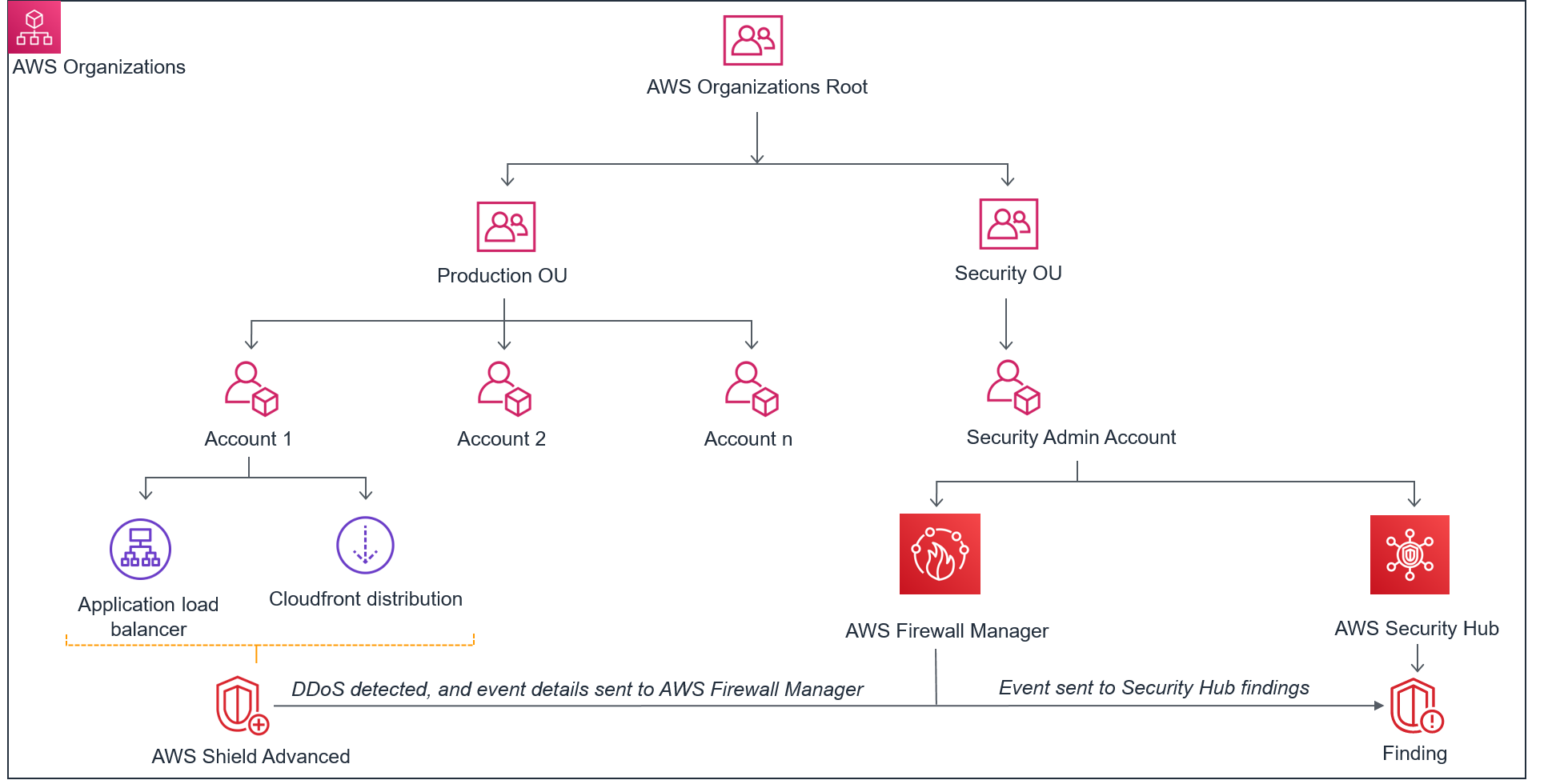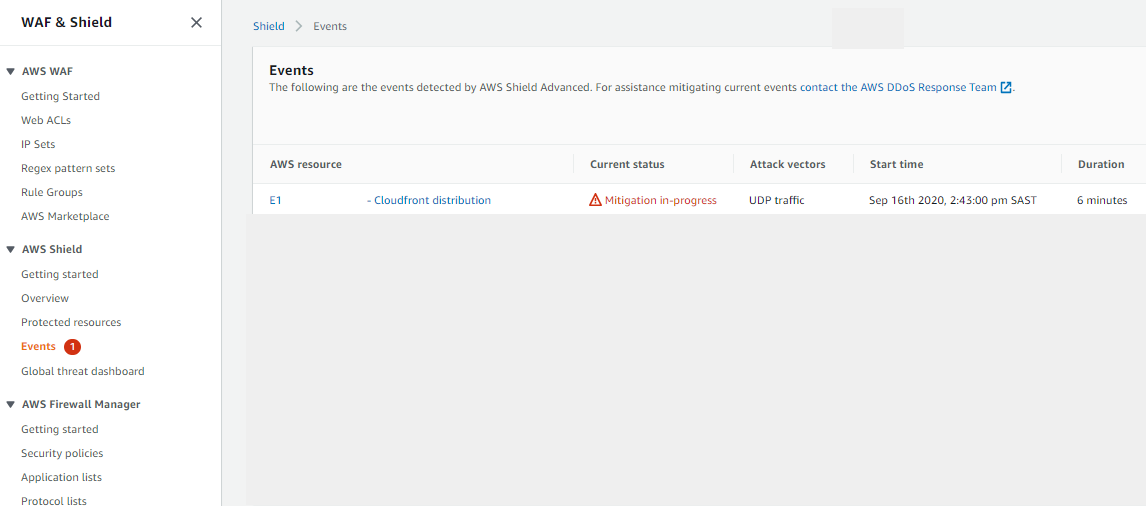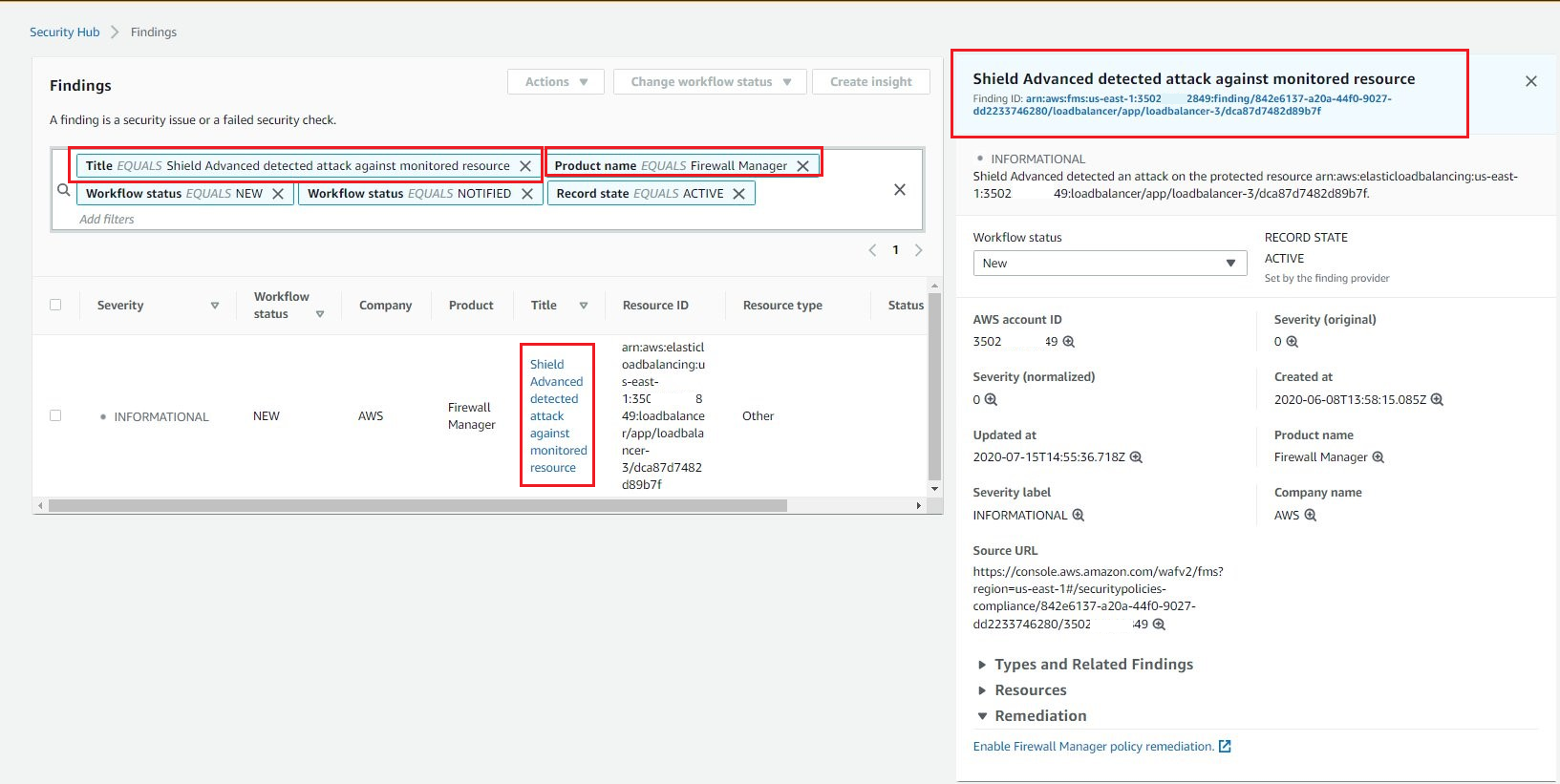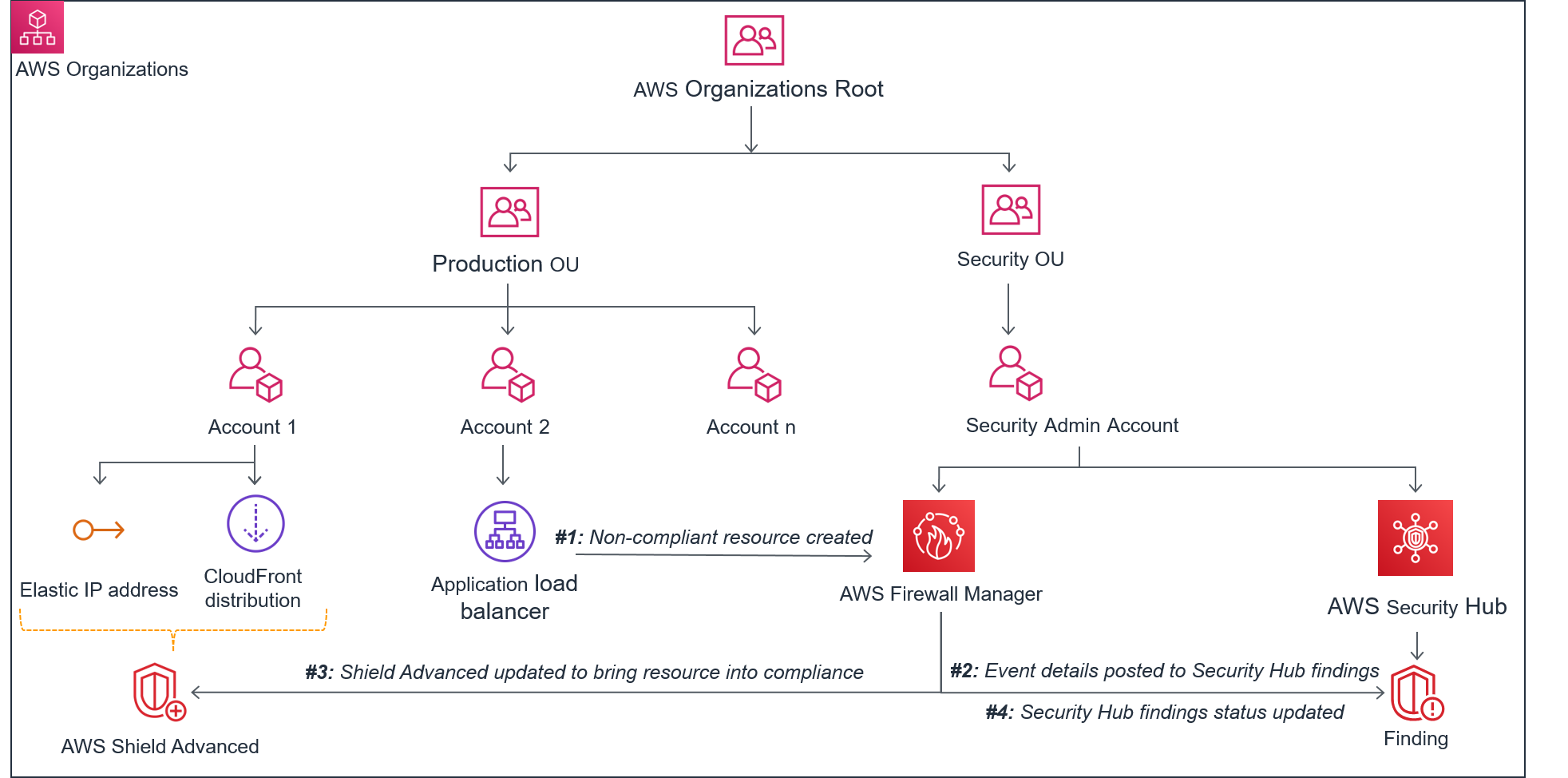AWS Security Blog
Set up centralized monitoring for DDoS events and auto-remediate noncompliant resources
When you build applications on Amazon Web Services (AWS), it’s a common security practice to isolate production resources from non-production resources by logically grouping them into functional units or organizational units. There are many benefits to this approach, such as making it easier to implement the principal of least privilege, or reducing the scope of adversely impactful activities that may occur in non-production environments. After building these applications, setting up monitoring for resource compliance and security risks, such as distributed denial of service (DDoS) attacks across your AWS accounts, is just as important. The recommended best practice to perform this type of monitoring involves using AWS Shield Advanced with AWS Firewall Manager, and integrating these with AWS Security Hub.
In this blog post, I show you how to set up centralized monitoring for Shield Advanced–protected resources across multiple AWS accounts by using Firewall Manager and Security Hub. This enables you to easily manage resources that are out of compliance from your security policy and to view DDoS events that are detected across multiple accounts in a single view.
Shield Advanced is a managed application security service that provides DDoS protection for your workloads against infrastructure layer (Layer 3–4) attacks, as well as application layer (Layer 7) attacks, by using AWS WAF. Firewall Manager is a security management service that enables you to centrally configure and manage firewall rules across your accounts and applications in an organization in AWS. Security Hub consumes, analyzes, and aggregates security events produced by your application running on AWS by consuming security findings. Security Hub integrates with Firewall Manager without the need for any action to be taken by you.
I’m going to cover two different scenarios that show you how to use Firewall Manager for:
- Centralized visibility into Shield Advanced DDoS events
- Automatic remediation of noncompliant resources
Scenario 1: Centralized visibility of DDoS detected events
This scenario represents a fully native and automated integration, where Shield Advanced DDoSDetected events (indicates whether a DDoS event is underway for a particular Amazon Resource Name (ARN)) are made visible as a security finding in Security Hub, through Firewall Manager.
Solution overview
Figure 1 shows the solution architecture for scenario 1.

Figure 1: Scenario 1 – Shield Advanced DDoS detected events visible in Security Hub
The diagram illustrates a customer using AWS Organizations to isolate their production resources into the Production Organizational Unit (OU), with further separation into multiple accounts for each of the mission-critical applications. The resources in Account 1 are protected by Shield Advanced. The Security OU was created to centralize security functions across all AWS accounts and OUs, obscuring the visibility of the production environment resources from the Security Operations Center (SOC) engineers and other security staff. The Security OU is home to the designated administrator account for Firewall Manager and the Security Hub dashboard.
Scenario 1 implementation
You will be setting up Security Hub in an account that has the prerequisite services configured in it as explained below. Before you proceed, see the architecture requirements in the next section. Once Security Hub is enabled for your organization, you can simulate a DDoS event in strict accordance with the AWS DDoS Simulation Testing Policy or use one of AWS DDoS Test Partners.
Architecture requirements
In order to implement these steps, you must have the following:
- An environment with AWS Organizations configured. At a minimum, an organization should be defined with at least two member accounts. For more details on setting up AWS Organizations, you can review the AWS Organizations User Guide and the blog post Best Practices for Organizational Units with AWS Organizations.
- A Firewall Manager administrator account set up with subscribed member accounts. For more details on setting up Firewall Manager administrator accounts, see AWS Firewall Manager prerequisites and the blog post Use AWS Firewall Manager to deploy protection at scale in AWS Organizations.
- AWS Config must be enabled in the accounts and Region where you have Shield Advanced–protected resources that you want to manage by using Firewall Manager. For managing Shield Advanced protected resources, you can choose to have AWS Config enabled on selected resource types, such as a Shield Advanced–supported resource.
- Shield Advanced must be enabled in all accounts you want to monitor using Security Hub and Firewall Manager.
Once you have all these requirements completed, you can move on to enable Security Hub.
Enable Security Hub
Note: If you plan to protect resources with Shield Advanced across multiple accounts and in multiple Regions, we recommend that you use the AWS Security Hub Multiaccount Scripts from AWS Labs. Security Hub needs to be enabled in all the Regions and all the accounts where you have Shield protected resources. For global resources, like Amazon CloudFront, you should enable Security Hub in the us-east-1 Region.
To enable Security Hub
- In the AWS Security Hub console, switch to the account you want to use as the designated Security Hub administrator account.
- Select the security standard or standards that are applicable to your application’s use-case, and choose Enable Security Hub.

Figure 2: Enabling Security Hub
- From the designated Security Hub administrator account, go to the Settings – Account tab, and add accounts by sending invites to all the accounts you want added as member accounts. The invited accounts become associated as member accounts once the owner of the invited account has accepted the invite and Security Hub has been enabled. It’s possible to upload a comma-separated list of accounts you want to send to invites to.

Figure 3: Designating a Security Hub administrator account by adding member accounts
View detected events in Shield and Security Hub
When Shield Advanced detects signs of DDoS traffic that is destined for a protected resource, the Events tab in the Shield console displays information about the event detected and provides a status on the mitigation that has been performed. Following is an example of how this looks in the Shield console.

Figure 4: Scenario 1 – The Events tab on the Shield console showing a Shield event in progress
If you’re managing multiple accounts, switching between these accounts to view the Shield console to keep track of DDoS incidents can be cumbersome. Using the Amazon CloudWatch metrics that Shield Advanced reports for Shield events, visibility across multiple accounts and Regions is easier through a custom CloudWatch dashboard or by consuming these metrics in a third-party tool. For example, the DDoSDetected CloudWatch metric has a binary value, where a value of 1 indicates that an event that might be a DDoS has been detected. This metric is automatically updated by Shield when the DDoS event starts and ends. You only need permissions to access the Security Hub dashboard in order to monitor all events on production resources. Following is an example of what you see in the Security Hub console.

Figure 5: Scenario 1 – Shield Advanced DDoS alarm showing in Security Hub
Configure Shield event notification in Firewall Manager
In order to increase your visibility into possible Shield events across your accounts, you must configure Firewall Manager to monitor your protected resources by using Amazon Simple Notification Service (Amazon SNS). With this configuration, Firewall Manager sends you notifications of possible attacks by creating an Amazon SNS topic in Regions where you might have protected resources.
To configure SNS topics in Firewall Manager
- In the Firewall Manager console, go to the Settings page.
- Under Amazon SNS Topic Configuration, select a Region.
- Choose Configure SNS Topic.

Figure 6: The Firewall Manager Settings page for configuring SNS topics
- Select an existing topic or create a new topic, and then choose Configure SNS Topic.

Figure 7: Configure an SNS topic in a Region
Scenario 2: Automatic remediation of noncompliant resources
The second scenario is an example in which a new production resource is created, and Security Hub has full visibility of the compliance state of the resource.
Solution overview
Figure 8 shows the solution architecture for scenario 2.

Figure 8: Scenario 2 – Visibility of Shield Advanced noncompliant resources in Security Hub
Firewall Manager identifies that the resource is out of compliance with the defined policy for Shield Advanced and posts a finding to Security Hub, notifying your operations team that a manual action is required to bring the resource into compliance. If configured, Firewall Manager can automatically bring the resource into compliance by creating it as a Shield Advanced–protected resource, and then update Security Hub when the resource is in a compliant state.
Scenario 2 implementation
The following steps describe how to use Firewall Manager to enforce Shield Advanced protection compliance of an application that is deployed to a member account within AWS Organizations. This implementation assumes that you set up Security Hub as described for scenario 1.
Create a Firewall Manager security policy for Shield Advanced protected resources
In this step, you create a Shield Advanced security policy that will be enforced by Firewall Manager. For the purposes of this walkthrough, you’ll choose to automatically remediate noncompliant resources and apply the policy to Application Load Balancer (ALB) resources.
To create the Shield Advanced policy
- Open the Firewall Manager console in the designated Firewall Manager administrator account.
- In the left navigation pane, choose Security policies, and then choose Create a security policy.
- Select AWS Shield Advanced as the policy type, and select the Region where your protected resources are. Choose Next.
Note: You will need to create a security policy for each Region where you have regional resources, such as Elastic Load Balancers and Elastic IP addresses, and a security policy for global resources such as CloudFront distributions.

Figure 9: Select the policy type and Region
- On the Describe policy page, for Policy name, enter a name for your policy.
- For Policy action, you have the option to configure automatic remediation of noncompliant resources or to only send alerts when resources are noncompliant. You can change this setting after the policy has been created. For the purposes of this blog post, I’m selecting Auto remediate any noncompliant resources. Select your option, and then choose Next.
Important: It’s a best practice to first identify and review noncompliant resources before you enable automatic remediation.
- On the Define policy scope page, define the scope of the policy by choosing which AWS accounts, resource type, or resource tags the policy should be applied to. For the purposes of this blog post, I’m selecting to manage Application Load Balancer (ALB) resources across all accounts in my organization, with no preference for resource tags. When you’re finished defining the policy scope, choose Next.

Figure 10: Define the policy scope
- Review and create the policy. Once you’ve reviewed and created the policy in the Firewall Manager designated administrator account, the policy will be pushed to all the Firewall Manager member accounts for enforcement. The new policy could take up to 5 minutes to appear in the console. Figure 11 shows a successful security policy propagation across accounts.

Figure 11: View security policies in an account
Test the Firewall Manager and Security Hub integration
You’ve now defined a policy to cover only ALB resources, so the best way to test this configuration is to create an ALB in one of the Firewall Manager member accounts. This policy causes resources within the policy scope to be added as protected resources.
To test the policy
- Switch to the Security Hub administrator account and open the Security Hub console in the same Region where you created the ALB. On the Findings page, set the Title filter to Resource lacks Shield Advanced protection and set the Product name filter to Firewall Manager.

Figure 12: Security Hub findings filter
You should see a new security finding flagging the ALB as a noncompliant resource, according to the Shield Advanced policy defined in Firewall Manager. This confirms that Security Hub and Firewall Manager have been enabled correctly.

Figure 13: Security Hub with a noncompliant resource finding
- With the automatic remediation feature enabled, you should see the “Updated at” time reflect exactly when the automatic remediation actions were completed. The completion of the automatic remediation actions can take up to 5 minutes to be reflected in Security Hub.

Figure 14: Security Hub with an auto-remediated compliance finding
- Go back to the account where you created the ALB, and in the Shield Protected Resources console, navigate to the Protected Resources page, where you should see the ALB listed as a protected resource.

Figure 15: Shield console in the member account shows that the new ALB is a protected resource
Confirming that the ALB has been added automatically as a Shield Advanced–protected resource means that you have successfully configured the Firewall Manager and Security Hub integration.
(Optional): Send a custom action to a third-party provider
You can send all regional Security Hub findings to a ticketing system, Slack, AWS Chatbot, a Security Information and Event Management (SIEM) tool, a Security Orchestration Automation and Response (SOAR), incident management tools, or to custom remediation playbooks by using Security Hub Custom Actions.
Conclusion
In this blog post I showed you how to set up a Firewall Manager security policy for Shield Advanced so that you can monitor your applications for DDoS events, and their compliance to DDoS protection policies in your multi-account environment from the Security Hub findings console. In line with best practices for account governance, organizations should have a centralized security account that performs monitoring for multiple accounts. Security Hub and Firewall Manager provide a centralized solution to help you achieve your compliance and monitoring goals for DDoS protection.
If you’re interested in exploring how Shield Advanced and AWS WAF help to improve the security posture of your application, have a look at the following resources:
- What’s new: AWS Shield Advanced proactive response
- Whitepaper: AWS Best Practices for DDoS Resiliency
- Blog post: Defense in depth using AWS Managed Rules for AWS WAF (part 1)
- Whitepaper: Guidelines for Implementing AWS WAF
If you have feedback about this post, submit comments in the Comments section below. If you have questions about this post, start a new thread on the AWS Security Hub forum or contact AWS Support.
Want more AWS Security how-to content, news, and feature announcements? Follow us on Twitter.